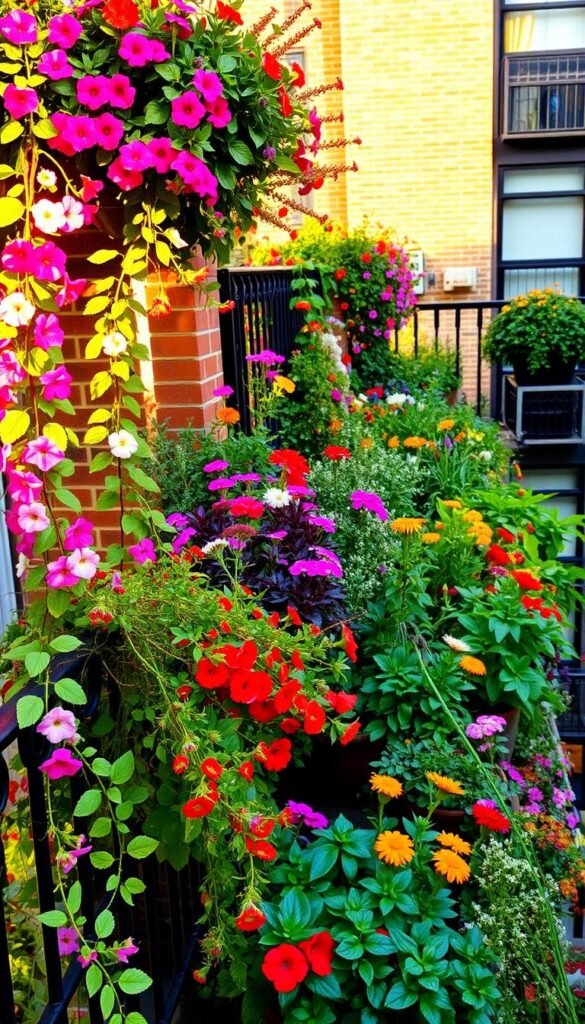Living in a city doesn’t mean sacrificing your love of greenery. Your balcony can become a lush retreat, even with limited square footage. All it takes is smart planning and a dash of creativity to turn overlooked corners into blooming sanctuaries.
Many assume tight spaces restrict gardening possibilities, but vertical planters, hanging baskets, and compact containers prove otherwise. These tools let you layer textures and colors without cluttering walkways. Thriving flower displays thrive when you match species to sunlight patterns and wind conditions unique to high-rise environments.
Even concrete jungles benefit from pockets of life. Fragrant herbs like lavender or rosemary add sensory appeal, while pollinator-friendly blooms support local ecosystems. Every potted plant contributes to cleaner air and a refreshing escape from urban noise.
You don’t need prior experience to start. Begin with hardy varieties like petunias or marigolds, then experiment as confidence grows. This guide will walk you through soil selection, watering hacks, and design tricks tailored to apartment living. Soon, your elevated oasis will feel like an extension of your home.
Introduction: Transform Your Balcony into a Floral Haven
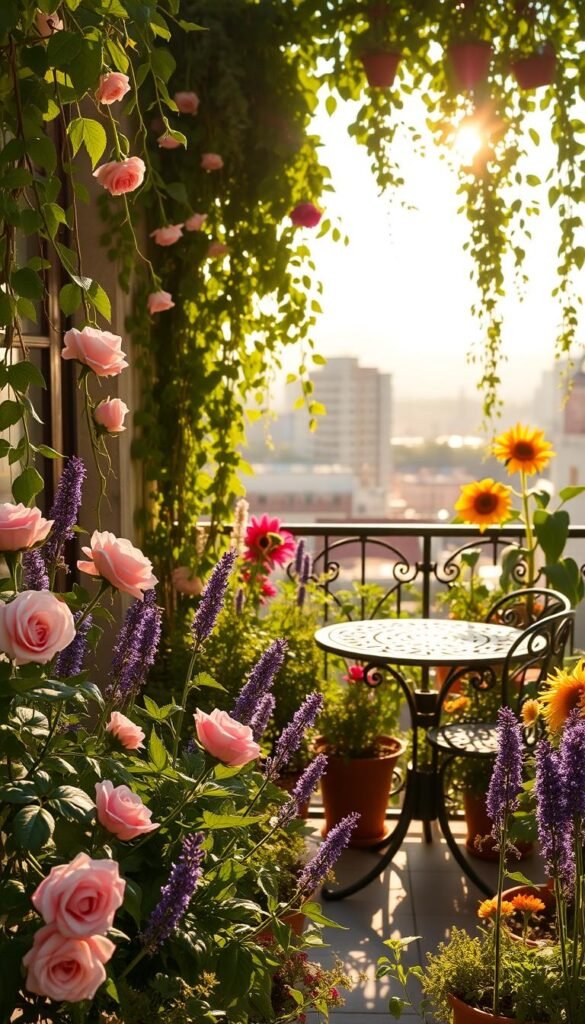
Urban living doesn’t have to mean giving up on green spaces—your balcony is the perfect canvas. With thoughtful design, this overlooked area becomes a sanctuary that blends beauty with purpose. Daily plant care routines offer more than visual appeal; studies show they reduce stress by up to 30% while fostering mindfulness.
Even modest outdoor areas can mirror your indoor living space, creating a seamless flow between rooms. A well-curated balcony garden acts as a natural air filter and sound buffer, softening the city’s relentless energy. The best part? You’ll harvest joy alongside blossoms as your efforts yield tangible results.
| Traditional Gardening | Balcony Gardening | Key Benefits |
|---|---|---|
| Requires large yards | Works in 10 sq. ft. | Space-efficient |
| Seasonal limitations | Portable containers | Year-round color |
| High maintenance | Customizable care | Low effort, high reward |
New gardeners often thrive with resilient species like succulents or zinnias. As confidence grows, experiment with vibrant container arrangements that reflect your personality. Your apartment balcony isn’t just a spot for morning coffee—it’s a living testament to nature’s adaptability.
Imagine stepping outside to birdsong and blooming petals instead of traffic noise. This achievable reality starts with one planter. What will you grow first?
The Benefits of Urban Balcony Gardening
Elevating your apartment lifestyle starts with transforming your balcony into a thriving green zone. Beyond aesthetics, these compact gardens offer measurable perks for your health, wallet, and environment. Let’s dig into why this trend keeps growing faster than morning glory vines.
Your elevated garden acts like a natural AC unit. Leafy plants reduce nearby temperatures by up to 9°F through shade and transpiration. This cooling effect lowers energy bills while creating a fresher living space during summer heatwaves.
Air quality improves dramatically too. Just six potted plants can remove 20% more airborne toxins in your home. Imagine breathing cleaner oxygen while snipping basil for tonight’s pasta—all steps from your sofa.
| Benefit Type | Short-Term Impact | Long-Term Value |
|---|---|---|
| Temperature Control | Immediate cooling | Lower energy costs |
| Air Quality | Reduced pollutants | Healthier lungs |
| Food Production | Fresh herbs daily | $200+ annual savings |
Butterflies and bees become regular visitors when you plant nectar-rich varieties like coneflowers or salvia. These pollinators boost biodiversity, even 20 floors up. For maximum sustainability, pair flowering plants with vegetable containers—nothing beats homegrown tomatoes still warm from the sun.
Mentally, tending plants lowers cortisol levels by 37% according to recent studies. Whether you’re deadheading petunias or watering mint, these small acts ground you in nature’s rhythms. Your balcony isn’t just growing plants—it’s cultivating joy.
Small Flower Garden Ideas for Urban Balconies: Bringing Nature to the City
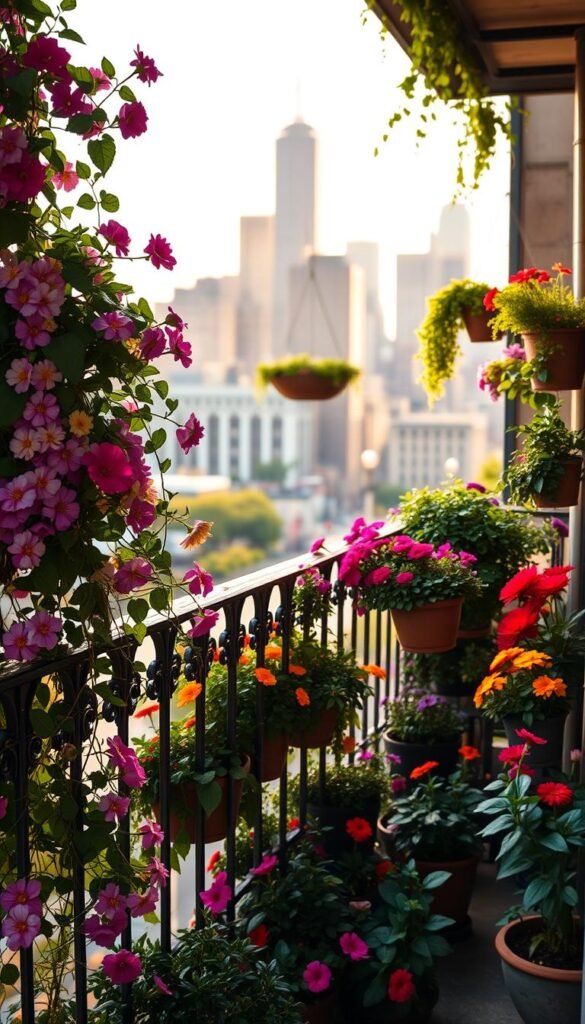
Your elevated outdoor area holds untapped potential for vibrant botanical displays. Start by defining your style—whether it’s a cottage-inspired retreat with cascading petunias or a sleek modern setup featuring geometric planters. Color coordination matters: pair warm-toned marigolds with purple salvias for contrast, or stick to monochromatic whites for serene elegance.
Layering plants creates depth in tight quarters. Place tall foxgloves at the back of containers, mid-height zinnias in the middle, and trailing lobelia at the edges. This approach maximizes vertical space while hiding utilitarian elements like railings or AC units.
Seasonal rotations keep your garden ideas fresh year-round. Swap spring tulips for summer geraniums, then transition to chrysanthemums in fall. For winter interest, add evergreen herbs like thyme or ornamental kale. Always match plant choices to your balcony’s microclimate—wind-tolerant species like gaillardia thrive where delicate blooms might struggle.
Blend aesthetics with practicality by using trellises as dual-purpose privacy screens and supports for climbing nasturtiums. Hanging ferns soften harsh walls while absorbing street noise. Remember: even a 4’x6’ balcony can host 20+ plants through smart container arrangements and vertical stacking.
Finally, inject personality with unexpected accents—painted terracotta pots, string lights woven through rail planters, or a miniature water feature. These touches transform functional space into an immersive escape that reflects your unique vision.
Assessing Your Space and Sunlight Conditions
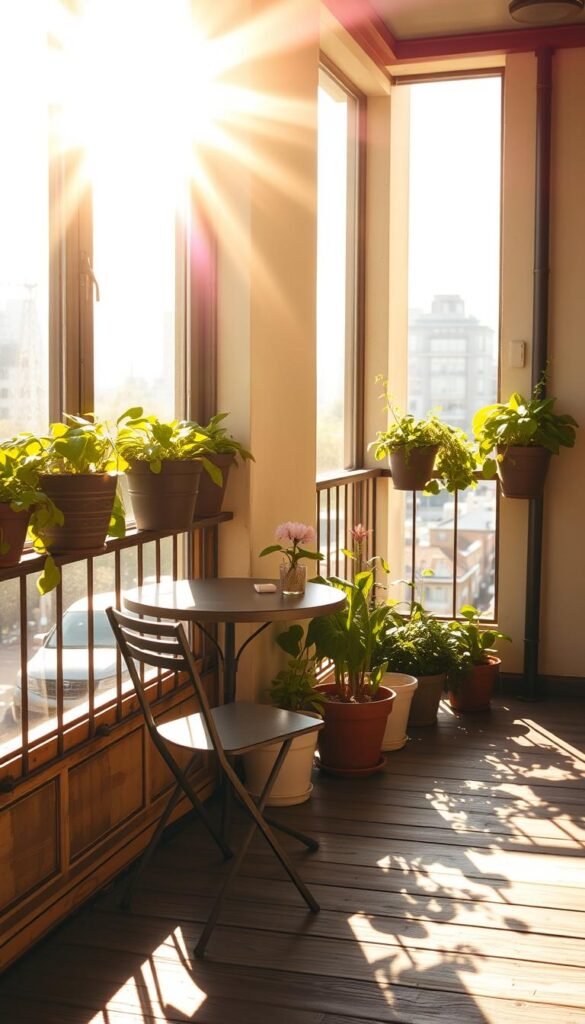
Unlocking your balcony’s potential starts with understanding its unique conditions. Think of it like matchmaking—pairing your space with plants that’ll thrive in its specific environment. This detective work ensures every inch works harder for your green vision.
Measuring Your Balcony’s Dimensions
Grab a tape measure and note three numbers: length, width, and rail height. These determine what fits where. A 4-foot-wide area? Opt for slim vertical planters instead of bulky pots. Check weight limits too—filled containers add up fast. Pro tip: Use painter’s tape to map out container placements before buying.
Understanding Your Sunlight Patterns
Track light exposure over three days using your phone’s timelapse feature. South-facing spots get marathon sun sessions—perfect for geraniums or lavender. North-facing? Embrace shade stars like begonias. Watch for sun blockers: neighboring buildings might create unexpected shadows at different times.
Wind patterns matter as much as light. High-rise dwellers often battle gusty conditions. Test yours by hanging lightweight ribbons—their dance reveals where sturdy plants like ornamental grasses belong. Heat bouncing off glass walls? Create cooling zones with moisture-loving ferns.
Creative Garden Design and Layout Inspiration
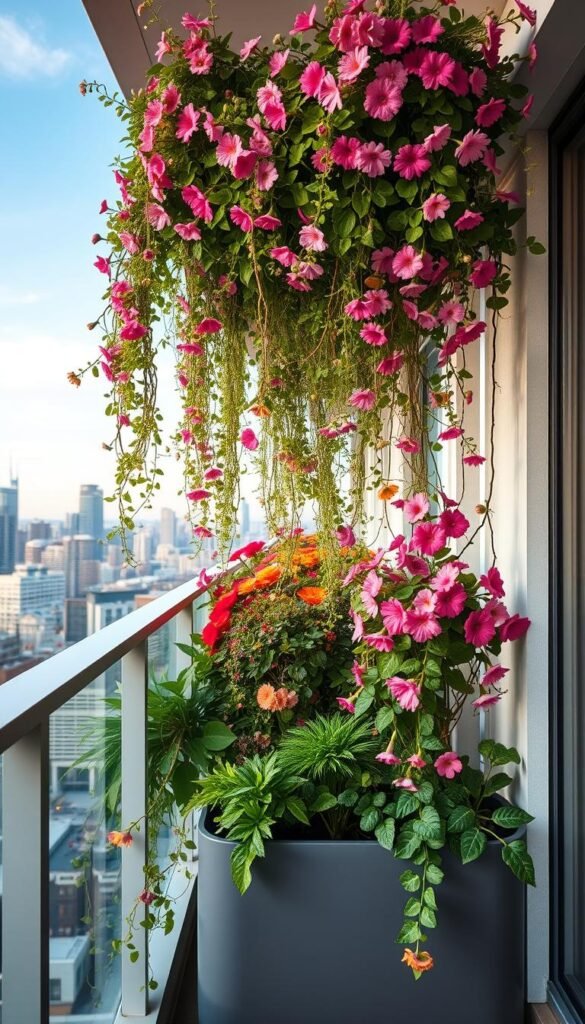
Your balcony’s walls and ceilings are blank canvases waiting for botanical artistry. By reimagining vertical space, you unlock triple the growing area while crafting eye-catching displays. Let’s explore how to turn structural limitations into design advantages.
Utilizing Vertical Spaces
Mount lightweight planters directly onto walls using rust-proof brackets. Stagger them diagonally to create movement. For railings, secure wire grids as climbing frames—morning glory vines will weave through them like living curtains. Overhead hooks? Perfect for trailing plants like ivy geraniums that cascade downward.
Incorporating Unique Containers
Ditch standard pots for upcycled items: vintage tin cans, wooden crates, or even old shoes. Modular planters with interlocking designs let you build custom shapes. Try stacking hexagonal wall units to form honeycomb patterns filled with succulents or herbs.
| Vertical System | Best Plants | Weight Capacity |
|---|---|---|
| Wall Pocket Planters | Strawberries, Petunias | 5 lbs per sq. ft. |
| Hanging Gutter Gardens | Lettuce, Pansies | 8 lbs per linear ft. |
| Freestanding Trellis | Clematis, Peas | 15 lbs total |
Layer textures by mixing tall grasses with feathery ferns in tiered shelves. Add depth using contrasting leaf shapes—broad hosta leaves behind spiky lavender. For practical container arrangements, group moisture-loving plants in self-watering boxes and drought-tolerant species in terracotta.
Safety first: distribute weight evenly across walls using multiple anchors. Test mounts with double the expected load—wind gusts add surprising force. Your vertical garden should thrill the eye without keeping you up at night!
Choosing the Right Containers, Pots, and Planters
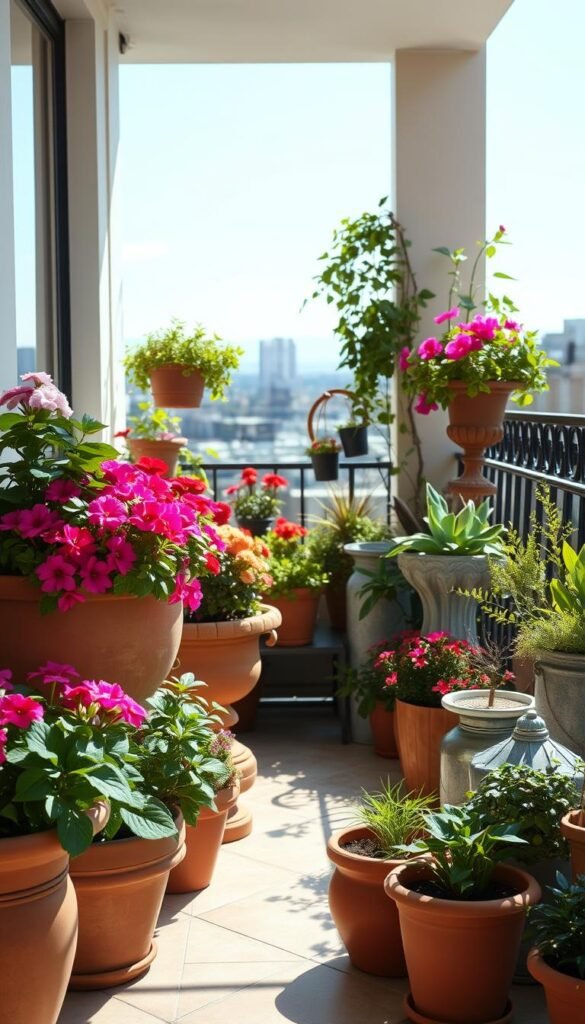
Your container choices shape your balcony garden’s success. Lightweight plastic and fiberglass planters shine in high-rise settings—they’re easier to rearrange and reduce strain on railings. But watch for windy days: secure them with bungee cords or decorative stones to prevent airborne accidents.
Fabric grow bags offer flexibility for seasonal changes. Roll them up when empty, then reuse next spring. Just remember: materials matter year-round. “Terracotta cracks below freezing, while cheap plastics become brittle,” notes Brooklyn gardener Lila Chen. Choose resin blends or insulated foam boxes for winter resilience.
| Material | Weight | Durability | Best For |
|---|---|---|---|
| Plastic | Light | 3-5 years | Annual flowers |
| Fiberglass | Medium | 10+ years | Small trees |
| Fabric | Ultralight | 2 seasons | Herbs/veggies |
| Ceramic | Heavy | Fragile | Sheltered spots |
Drainage keeps roots healthy. Drill extra holes in solid-bottomed containers, or layer gravel beneath soil. For decorative pots without openings, use them as cachepots—nest plastic liners inside. This trick combines style with practicality.
Match pot size to plant needs. Shallow containers suit succulents, while deep ones support tomato roots. Always check mature dimensions: a 6-inch starter pot might need upgrading as plants grow. Your planters should evolve alongside your green companions.
Selecting the Best Flowers and Herbs for Your Balcony
Curating your elevated garden begins with smart plant pairings. Sun exposure and space constraints dictate your choices, but countless options exist for every scenario. Let’s explore best plants that deliver color, fragrance, and practicality in compact settings.
Top Blooming Varieties
Petunias and marigolds dominate balcony gardens for good reason—they bloom relentlessly with minimal fuss. Geraniums add vibrant pops of red or pink while tolerating afternoon heat. For shady spots, impatiens and begonias thrive where other flowers might falter.
Perennial lovers should consider lavender or salvia. These drought-resistant beauties return yearly, saving time and money. Always match pot depth to root systems: shallow containers suit pansies, while deeper ones support dahlia tubers.
Herb Garden Essentials
Transform your railings into a kitchen ally with aromatic herbs. Basil and oregano demand full sun, yielding leaves for sauces and salads weekly. Partial-shade areas? Parsley and cilantro flourish with just 4 hours of daylight. Mint grows aggressively—keep it solo to prevent takeover.
For year-round interest, mix edible and ornamental varieties. Purple sage adds texture, while thyme spills gracefully from hanging planters. Need guidance? Our container gardening basics simplify soil and pot selection.
Vertical Gardening and Hanging Planter Ideas
Elevate your green thumb game by looking up—your balcony’s vertical spaces hold untapped growing potential. Clever use of walls and railings lets you cultivate lush displays while keeping walkways clear. Vertical garden systems turn structural surfaces into living art galleries that refresh daily.
Wall-mounted Solutions
Transform blank walls into botanical tapestries with modular planting systems. Fabric pocket panels let you grow herbs like thyme in individual compartments, while magnetic pots attach directly to metal surfaces. “Interlocking resin trays create instant green walls,” notes urban gardener Marco Torres. Wall planters work best when staggered diagonally—this creates visual flow and ensures even sunlight distribution.
| System Type | Best Plants | Max Weight |
|---|---|---|
| Pocket Panels | Strawberries, Succulents | 15 lbs per panel |
| Magnetic Pots | Basil, Oregano | 3 lbs each |
| Stackable Trays | Lettuce, Pansies | 25 lbs per column |
Rail-Based Planting Techniques
Your balcony’s railing isn’t just a safety feature—it’s prime real estate for hanging baskets and clamp-on boxes. Use adjustable brackets to secure lightweight planters filled with trailing lobelia or cherry tomatoes. For windy locations, choose low-profile containers that sit flush against rails rather than swinging freely.
Mix functional and decorative elements by training jasmine vines along horizontal wires. This approach creates natural shade screens while filling the air with fragrance. Always check weight limits—most metal rails handle 10-15 lbs per linear foot safely.
Smart Watering Techniques and Soil Preparation
Mastering moisture and soil quality transforms your elevated garden from surviving to thriving. Limited water access and environmental factors demand clever solutions. Let’s explore how to keep plants hydrated and nourished without constant effort.
Efficient Watering Strategies
Self-watering pots with built-in reservoirs cut daily chores by 40%. Fill them weekly, and capillary action delivers moisture as needed. For traditional containers, water deeply at dawn—this reduces evaporation and prevents leaf scorch.
Group plants with similar thirst levels together. Succulents in one zone, moisture-loving ferns in another. Use a long-spout watering can to target roots without splashing leaves. Bonus: collect rainwater in decorative barrels during storms for free irrigation.
Soil and Fertilizer Tips
Start with quality soil—look for mixes labeled “container gardening.” These retain moisture better than standard dirt. Blend in perlite or vermiculite for improved drainage, especially in shallow pots.
Slow-release fertilizers feed plants for months without overloading them. Top-dress containers quarterly with compost for organic nutrition. Always check soil moisture before watering—stick your finger an inch deep. If it’s damp, wait another day.

